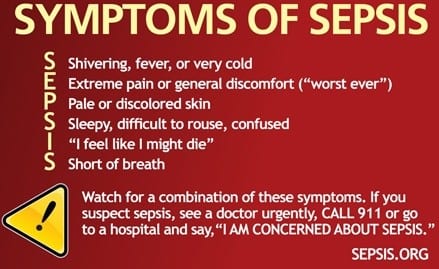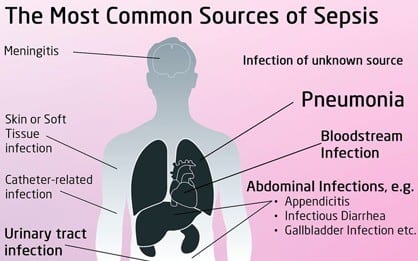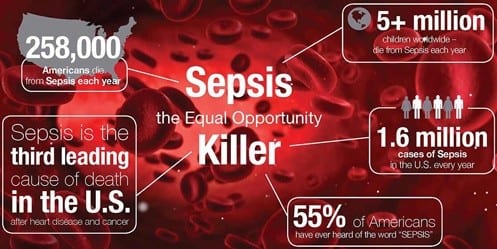What is Sepsis?
Blue indicates link

Sepsis is a potentially life-threatening condition caused by the body’s response to an infection. The body normally releases chemicals into the bloodstream to fight infection. Sepsis occurs when the body’s response to these chemicals is out of balance, triggering changes that can damage multiple organ systems.
If sepsis progresses to septic shock, blood pressure drops dramatically. This may lead to death.
Sepsis is the body’s extreme response to an infection. It is a life-threatening medical emergency.
Sepsis happens when an infection you already have —in your skin, lungs, urinary tract, or somewhere else—triggers a chain reaction throughout your body.
Without timely treatment, sepsis can rapidly lead to tissue damage, organ failure, and death.
Sepsis is a life-threatening illness caused by your body’s response to an infection. Your immune system protects you from many illnesses and infections, but it’s also possible for it to go into overdrive in response to an infection.
Sepsis develops when the chemicals the immune system releases into the bloodstream to fight an infection cause inflammation throughout the entire body instead. Severe cases of sepsis can lead to septic shock, which is a medical emergency.
There are more than 1.5 million cases of sepsis each year, according to the Centers for Disease Control and Prevention (CDC). This type of infection kills more than 250,000 Americans a year.
Sepsis — a common cause of death from coronavirus
Many coronavirus patients have died of sepsis — when the body’s immune system goes into overdrive. How does sepsis occur, what are the warning signs, and how is it treated?
What are the symptoms of sepsis?

There are three stages of sepsis: sepsis, severe sepsis, and septic shock. Sepsis can happen while you’re still in the hospital recovering from a procedure, but this isn’t always the case.
It’s important to seek immediate medical attention if you have any of the below symptoms. The earlier you seek treatment, the greater your chances of survival.
Symptoms of sepsis include:
- a fever above 101ºF (38ºC) or a temperature below 96.8ºF (36ºC)
- heart rate higher than 90 beats per minute
- breathing rate higher than 20 breaths per minute
- probable or confirmed infection
You must have two of these symptoms before a doctor can diagnose sepsis.
Severe sepsis:
Severe sepsis occurs when there’s organ failure. You must have one or more of the following signs to be diagnosed with severe sepsis:
- patches of discolored skin
- decreased urination
- changes in mental ability
- low platelet (blood clotting cells) count
- problems breathing
- abnormal heart functions
- chills due to a fall in body temperature
- unconsciousness
- extreme weakness
Septic shock:
Symptoms of septic shock include the symptoms of severe sepsis, plus very low blood pressure.
The serious effects of sepsis:
Although sepsis is potentially life-threatening, the illness ranges from mild to severe. There’s a higher rate of recovery in mild cases.
Septic shock has close to a 50 percent mortality rate, according to the Mayo Clinic. Having a case of severe sepsis increases your risk of a future infection.
Severe sepsis or septic shock can also cause complications. Small blood clots can form throughout your body. These clots block the flow of blood and oxygen to vital organs and other parts of your body. This increases the risk of organ failure and tissue death (gangrene).
What causes sepsis?
In addition to the known seasonal influenza viruses, other viruses that are highly infectious, such as coronaviruses, Ebola and yellow fever viruses, dengue, swine flu, or bird flu viruses can also cause sepsis.
Any infection can trigger sepsis, but the following types of infections are more likely to cause sepsis:
- pneumonia
- abdominal infection
- kidney infection
- bloodstream infection

According to the National Institute of General Medical Sciences, the number of sepsis cases in the United States increases every year. Possible reasons for the increase include:
- an aging population, because sepsis is more common in seniors
- an increase in antibiotic resistance, which happens when an antibiotic loses its ability to resist or kill bacteria
- an increase in the number of people with illnesses that weaken their immune systems
- Coronaviruses
- Influenza
- Burns
- The wrong medication
Who is at risk for sepsis?
Although some people have a higher risk of infection, anyone can get sepsis. People who are at risk include:
- Young children and seniors
- people with weaker immune systems, such as those with HIV or those in chemotherapy treatment for cancer
- people being treated in an intensive care unit (ICU)
- People exposed to invasive devices, such as intravenous catheters or breathing tubes
Newborns and sepsis:
Neonatal sepsis is when your baby gets a blood infection within the first month of life. Neonatal sepsis is classified based on the timing of the infection, according to whether the infection was contracted during the birth process (early-onset) or after birth (late-onset).
This helps the doctor decide what kind of treatment to administer. Low birth weight and premature babies are more susceptible to late-onset sepsis because their immune systems are immature. While symptoms can be subtle and nonspecific, some signs include:
- listlessness
- not breastfeeding well
- low body temperature
- apnea (temporary stopping of breathing)
- fever
- pale color
- Poor skin circulation with cool extremities
- abdominal swelling
- vomiting
- diarrhea
- seizures
- jitteriness
- yellowing of the skin and whites of the eyes (jaundice)
- problems feeding
Neonatal sepsis is still a leading cause of infant death, but with early diagnosis and treatment, the baby will recover completely and have no other problems. With maternal universal screening and proper neonatal testing, the risk of neonatal sepsis has decreased significantly.
Seniors and sepsis:
Since our immune system weakens as we age, seniors can be at risk for sepsis. In one 2006 study, people over the age of 65 made up nearly 70 percent of sepsis cases.
In addition, chronic illnesses, such as diabetes, kidney disease, cancer, high blood pressure, and HIV, are commonly found in those who have sepsis. The most common types of infections to cause sepsis in seniors are respiratory like pneumonia or genitourinary like a urinary tract infection.
Other infections can come with infected skin due to pressure sores or skin tearing. While these infections might not be noticed for a while, confusion or disorientation is a common symptom to look for when identifying infection in seniors.
Is sepsis contagious?
Sepsis isn’t contagious. However, the pathogens that caused the original infection that led to sepsis can be contagious. Sepsis spreads within a person’s body from the original source of infection to other organs through the bloodstream.
How is sepsis diagnosed?
If you have symptoms of sepsis, your doctor will order tests to make a diagnosis and determine the severity of your infection.
One of the first tests is a blood test. Your blood is checked for complications like:
- infection
- clotting problems
- abnormal liver or kidney function
- decreased amount of oxygen
- an imbalance in minerals called electrolytes that affect the amount of water in your body as well as the acidity of your blood
Depending on your symptoms and the results of your blood test, your doctor may order other tests, including:
- a urine test (to check for bacteria in your urine)
- a wound secretion test (to check an open wound for an infection)
- a mucus secretion test (to identify germs responsible for an infection)
If your doctor can’t determine the source of infection using the above tests, they may order an internal view of your body using one of the following:
- X-rays to view the lungs
- CT scans to view possible infections in the appendix, pancreas, or bowel area
- ultrasounds to view infections in the gallbladder or ovaries
- MRI scans, which can identify soft tissue infections
Sepsis criteria:
There are two tools or sets of criteria, doctors use to determine the severity of your condition. One is the systemic inflammatory response syndrome (SIRS). SIRS is defined when you meet two or more of the following criteria:
- fever of more than 100.4°F (38°C) or less than 96.8°F (36°C)
- a heart rate of more than 90 beats per minute
- respiratory rate of more than 20 breaths per minute or arterial carbon dioxide tension (PaCO2) of less than 32 mm Hg
- Abnormal white blood cell count
Another tool is the quick sequential organ failure assessment (qSOFA). It uses the results of three criteria:
- Low blood pressure reading
- High respiratory rate (greater than 22 breaths per minute)
- Glasgow coma scale score of less than 15 (This scale is used to determine your level of consciousness.)
A positive qSOFA is determined if two or more of the above measurements are abnormal. Some physicians prefer using qSOFA because, unlike the SIRS criteria, qSOFA doesn’t require laboratory tests. The results of either of these assessments will help your doctor determine care.
How is sepsis treated?
Sepsis can quickly progress to septic shock and death if it’s left untreated. Doctors use a number of medications to treat sepsis, including:
- antibiotics via IV to fight infection
- vasoactive medications to increase blood pressure
- insulin to stabilize blood sugar
- corticosteroids to reduce inflammation
- painkillers
Severe sepsis may also require large amounts of IV fluids and a respirator for breathing. Dialysis might be necessary if the kidneys are affected. Kidneys help filter harmful wastes, salt, and excess water from the blood. In dialysis, a machine performs these functions.
In some cases, surgery may be needed to remove the source of infection. This includes draining a pus-filled abscess or removing infected tissue.
Although sepsis is common in hospitals, it’s often detected very late. When diagnosed, sepsis is immediately treated as an emergency. The blood is examined, a broad-spectrum antibiotic is administered, and sufficient blood circulation and ventilation are ensured. As a precautionary measure, many sepsis patients are “professionally incubated,” i.e. put into an artificial coma.
Ventilation equipment and/or circulatory therapy, kidney replacement therapy, or coagulation therapy are used to support the patient’s organs in particular.
Such intensive care treatment is highly complex and costly. In the US alone, around 24 billion dollars (€21.5 billion) are spent annually in hospitals for sepsis treatment.
More important than the costs, however, are the available capacities: existing intensive care beds should therefore primarily be available to those who are critically ill with the new coronavirus or other pathogens and who urgently need respiratory care, for example, due to sepsis.
Long-term consequences:
In half of the patients, sepsis occurs without serious consequences. In the other half, infections, kidney failure, or cardiovascular problems, i.e. cardiovascular diseases, can recur about three months after discharge.
In addition, many sepsis patients suffer severe, long-term functional, cognitive, or psychological consequences such as paralysis, depression, or anxiety disorders.
It is therefore of central importance that sepsis is prevented if possible or diagnosed as early as possible. The earlier the disease is diagnosed, the higher the chances of survival and therapy.

Personal Note:
I am a huge advocate for natural and home remedies. In this case, I would ask you to be rushed to a medical facility if you show any signs of sepsis. I had a friend die of septic shock.
If you are a distance away from a medical facility here are some things you may take to help.
5 Effective Home Remedies for Sepsis – Blood Infections and Poisoning Treatment
Sepsis or blood poisoning is a life-threatening medical emergency. It requires immediate medical attention however home remedies can be very useful as a supplementary treatment.
1. Vitamin C
In scientific research published in 2010 (Lawson Health Research Institute at the University of Ontario), the researchers found that a heavy dose of vitamin C injections found significant improvements in the survival rates of mice. Vitamin C or ascorbic acid fights oxidative stresses and doesn’t allow blood to clot at the small capillaries of vital organs. This saves the organ and saves a life.
So while your doctor may be treating you with antibiotics or any other method, eating citrus fruits such as oranges and lemons will certainly help.
Drink a glass of fresh orange juice three times a day. Take Vitamin C supplements and improve your Immunity and survive against sepsis.
2. Turmeric
Turmeric has been used to fight infections from ancient times and it does help in sepsis too.
Turmeric increases the protein levels in the blood that fight infections. Turmeric is also anti-inflammatory so the pain, swelling, and redness can also be reduced.
Add one teaspoon of turmeric to a glass of warm water. Mix it well.
Drink this concoction in the morning every day to recover fast from sepsis.
3. Garlic and Honey
Garlic is highly anti-inflammatory with mild antibacterial and antifungal properties. The sulfur compound Allicin helps to fight infections and boost immunity, therefore it is a powerful remedy for sepsis.
Honey modulates the immune system which makes it very good for sepsis treatment.
Peel a large clove of garlic and shred it, add one teaspoon of honey, and mix it well. Eat the mixture daily early in the morning and increase your immunity.
This will help you to get out of sepsis quickly.
4. Potato
Potato Juice is a natural topical remedy for sepsis inflammations if any.
Sepsis inflammations may appear on the skin. Apply potato juice or potato slices on the affected area. Make thin slices of potato and keep them on the inflamed area. Rub it slowly replace it with another slice and continue for 15-20 minutes.
You can also extract potato juice and apply the juice with cotton balls.
Your sepsis inflammation pain will subside.
5. Lobelia and Slippery Elm
Both these herbs are powerful remedies for external use on sepsis wounds.
If a bacterial infection of a wound was the cause of your sepsis, then the wound must be healed properly.
Both the herbs lobelia and slippery elm are good for sepsis.
Take them in equal quantities to make a soft paste with water. Apply the paste on the wound or cut and tie it with a surgical bandage.
Remove the bandage, clean the area with antiseptic, apply the paste, and tie it with another clean bandage. Do it until the wound is healed.
Remember Sepsis is a life-threatening condition, do not take chances. ICU is the place to be in. Be there, improve your condition, and then begin natural cures to recover fast.
Can you recover from sepsis?
Your recovery from sepsis depends on the severity of your condition and any preexisting conditions you might have. Many people who survive will recover completely. However, others will report lasting effects.
The UK Sepsis Trust says it can take up to 18 months before survivors start to feel like their normal selves. The Sepsis Alliance says that around 50 percent of sepsis survivors deal with post-sepsis syndrome (PSS). The alliance says this condition includes long-term effects such as:
- damaged organs
- insomnia
- nightmares
- disabling muscle and joint pains
- fatigue
- poor concentration
- lowered cognitive functioning
- lowered self-esteem
Severe cases of sepsis can lead to death.
Sepsis prevention:
Taking steps to prevent the spread of infection can reduce your risk of developing sepsis. These include:
- Staying up to date on your vaccinations. Get vaccinated for the flu, pneumonia, and other infections.
- Practicing good hygiene. This means practicing proper wound care, handwashing, and bathing regularly.
- Getting immediate care if you develop signs of infection. Every minute counts when it comes to sepsis treatment. The sooner you get treatment, the better the outcome.
Outlook:
It’s important to remember that sepsis is a medical emergency. Every minute and hour counts, especially since the infection can spread quickly. There’s no one symptom of sepsis, but rather it has a combination of symptoms.
Get immediate medical attention if you suspect that you have sepsis, especially if you have a known infection.
Sepsis or blood poisoning is a life-threatening medical emergency. It requires immediate medical attention however home remedies can be very useful as a supplementary treatment.
Thank you for reading,
Michael.
Comments are welcome
Your description of SEPSIS offers a refreshingly honest and clear description of one of the causes of death due to this dreaded virus that is sweeping the globe. Probably the most important paragraph for me is 1.10 which offers some important and helpful advice on how to treat SEPSIS. Thank you for sharing this incredibly important advice. The home remedies you suggest are also invaluable. Thank you. Keep safe and thank you for the advice. I have bookmarked this helpful page. Just in case…
Hi Trevor,
Thank you for your comments. I actually did not know too much about sepsis. I decided to do some research on it after a friend died of it. I normally encourage people to try natural remedies, but in this case, I did leave a warning and suggested rushing the person to a medical facility.
All the best,
Michael